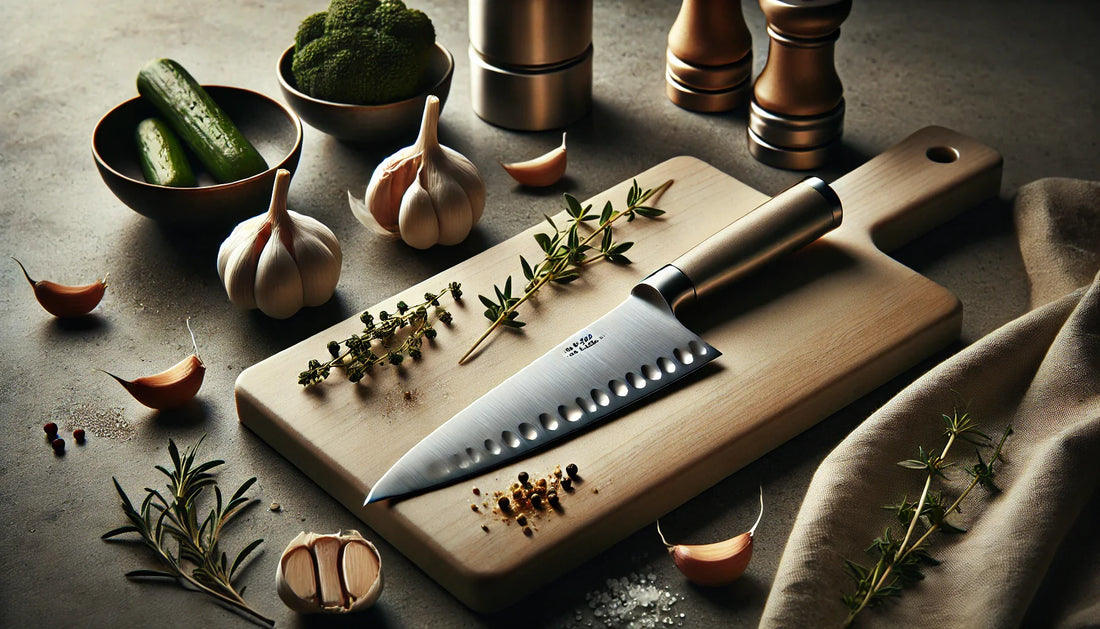
The Best Chef’s Knife: Why You Need a Japanese Damascus Chef’s Knife in Your Kitchen
Share
When it comes to cooking, every chef—whether professional or home-based—knows that the best chef’s knife is the most important tool in the kitchen. But with so many options on the market, how do you decide which chef’s knife is the right one for you? In this post, we’ll explore the uses of a chef’s knife, dive into the differences between Japanese chef’s knives and German chef’s knives, and why a Damascus chef’s knife like SEKKIN’s could be your perfect fit.
What is a Chef’s Knife?
A chef’s knife is a multifunctional kitchen tool designed to handle a wide range of cutting tasks. From chopping vegetables to slicing meat, its broad, sharp blade makes it essential for everyday use, a key part of everyone's cooking routine. Typically ranging from 6 to 12 inches in length, the chef’s knife is ideal for tasks that require precision and control.
What is a Chef’s Knife Used For?
The chef’s knife uses are broad and varied. Here are some of the most common tasks this knife is made for:
- Chopping vegetables: Whether you’re dicing onions or julienning carrots, a chef’s knife offers the size and balance needed for speed and precision.
- Slicing meat: Its long, sharp blade allows you to slice easily through raw or cooked meat.
- Mincing herbs: The curved blade lets you rock the knife back and forth, making quick work of fresh herbs.
- Crushing garlic: The flat side of the blade can easily crush garlic cloves - and who can live without garlic?
In short, the best chef’s knife is your all-in-one tool for nearly every kitchen task.
Japanese Chef’s Knife vs. German Chef’s Knife: Which is Better?
One of the most common questions people have is whether to go with a Japanese chef’s knife or a German chef’s knife. Both are top contenders, but they each have distinct qualities:
- Japanese Chef’s Knives: Known for their razor-sharp edges, Japanese knives like the SEKKIN Damascus chef’s knife are lightweight, precise, and typically have a thinner blade. They are ideal for more delicate tasks, such as slicing fish or vegetables.
- German Chef’s Knives: These tend to be heavier with a thicker blade, designed for durability. German knives can handle tougher ingredients, like dense root vegetables or harder cuts of meat.
While both are excellent choices, the Japanese chef’s knife is often preferred by those who prioritize sharpness and precision, making it the perfect option for chefs who value finesse over force.
Why Choose a Damascus Chef’s Knife?
A Damascus chef’s knife combines the best of both worlds. Crafted with 67 or more layers of high-carbon stainless steel, it delivers the strength of German knives with the sharpness of Japanese blades. The unique and aesthetic wavy patterns on the steel make the knife a work of art and add durability and flexibility to the blade.
SEKKIN’s Damascus chef’s knife exemplifies these qualities, offering a balance that few knives can match. The intricate layering of steel ensures that the blade retains its sharpness longer while remaining easy to maneuver.
Chef’s Knife Description: What Makes SEKKIN Stand Out
We designed the SEKKIN Japanese chef’s knife to make it about cutting performance and enhancing your entire cooking experience. Here’s what sets it apart:
- 67-layers of Japanese Damascus steel: This gives the blade strength, durability and its signature pattern.
- Japanese AUS10 steel core: Provides unmatched sharpness and edge retention.
- Ergonomic handle with buffalo horn bolster: This high-quality handle ensures a comfortable grip, perfect for long hours in the kitchen.
Every SEKKIN chef’s knife is designed with both functionality and beauty in mind, making it an essential tool for anyone serious about their cooking.
How to Choose the Best Chef’s Knife for You
When looking for the best chef’s knife, consider the following:
- Blade material: High-carbon stainless steel, like Damascus steel, offers durability and edge retention.
- Handle: Look for a handle that fits comfortably in your hand and provides a secure grip, like SEKKIN’s Pakkawood and buffalo horn combination. We also strongly recommend more durable handle materials such as Fiberglass / G10.
- Length: For most home cooks, an 8-inch chef’s knife is ideal, as it’s large enough for most tasks without being too unwieldy.
Whether you’re new to cooking or a seasoned chef, having the best chef’s knife in your kitchen can truly make all the difference. With its sharpness, precision and durability, a Japanese chef’s knife like SEKKIN’s Damascus chef’s knife can take your cooking to new heights. If you’re ready to invest in a knife that will last a lifetime and enhance your culinary skills, check out SEKKIN’s collection today.
